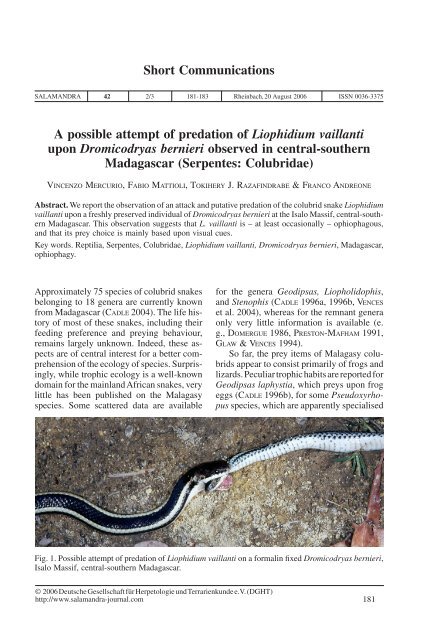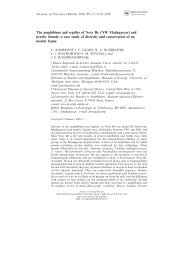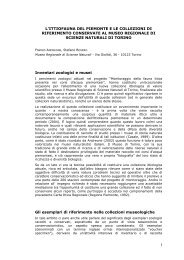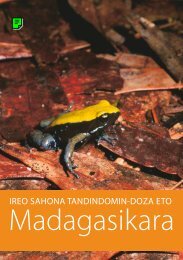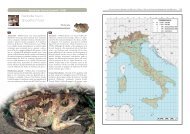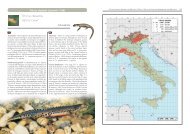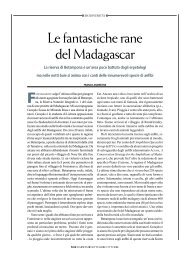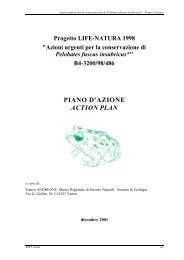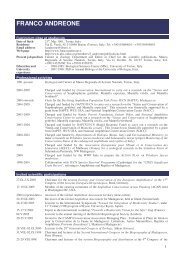Short Communications A possible attempt of ... - Franco Andreone
Short Communications A possible attempt of ... - Franco Andreone
Short Communications A possible attempt of ... - Franco Andreone
Create successful ePaper yourself
Turn your PDF publications into a flip-book with our unique Google optimized e-Paper software.
<strong>Short</strong> <strong>Communications</strong><strong>Short</strong> <strong>Communications</strong>SALAMANDRA422/3181-183Rheinbach, 20 August 2006 ISSN 0036-3375A <strong>possible</strong> <strong>attempt</strong> <strong>of</strong> predation <strong>of</strong> Liophidium vaillantiupon Dromicodryas bernieri observed in central-southernMadagascar (Serpentes: Colubridae)VINCENZO MERCURIO, FABIO MATTIOLI, TOKIHERY J. RAZAFINDRABE & FRANCO ANDREONEAbstract. We report the observation <strong>of</strong> an attack and putative predation <strong>of</strong> the colubrid snake Liophidiumvaillanti upon a freshly preserved individual <strong>of</strong> Dromicodryas bernieri at the Isalo Massif, central-southernMadagascar. This observation suggests that L. vaillanti is – at least occasionally – ophiophagous,and that its prey choice is mainly based upon visual cues.Key words. Reptilia, Serpentes, Colubridae, Liophidium vaillanti, Dromicodryas bernieri, Madagascar,ophiophagy.Approximately 75 species <strong>of</strong> colubrid snakesbelonging to 18 genera are currently knownfrom Madagascar (CADLE 2004). The life history<strong>of</strong> most <strong>of</strong> these snakes, including theirfeeding preference and preying behaviour,remains largely unknown. Indeed, these aspectsare <strong>of</strong> central interest for a better comprehension<strong>of</strong> the ecology <strong>of</strong> species. Surprisingly,while trophic ecology is a well-knowndomain for the mainland African snakes, verylittle has been published on the Malagasyspecies. Some scattered data are availablefor the genera Geodipsas, Liopholidophis,and Stenophis (CADLE 1996a, 1996b, VENCESet al. 2004), whereas for the remnant generaonly very little information is available (e.g., DOMERGUE 1986, PRESTON-MAFHAM 1991,GLAW & VENCES 1994).So far, the prey items <strong>of</strong> Malagasy colubridsappear to consist primarily <strong>of</strong> frogs andlizards. Peculiar trophic habits are reported forGeodipsas laphystia, which preys upon frogeggs (CADLE 1996b), for some Pseudoxyrhopusspecies, which are apparently specialisedFig. 1. Possible <strong>attempt</strong> <strong>of</strong> predation <strong>of</strong> Liophidium vaillanti on a formalin fixed Dromicodryas bernieri,Isalo Massif, central-southern Madagascar.© 2006 Deutsche Gesellschaft für Herpetologie und Terrarienkunde e.V. (DGHT)http://www.salamandra-journal.com181
<strong>Short</strong> <strong>Communications</strong>to eat hard-bodies lizards (CADLE 1999), andfor a single dissected museum specimen <strong>of</strong>Micropisthodon ochraceus which containedat least four snails (CADLE 2003). Liopholidophisrhadinaea is also known to prey uponamphibian eggs (CADLE 1996a). Ophiophagyis only reported for Mimophis mahfalensisand for Madagascarophis species (DOMER-GUE 1987, PRESTON-MAFHAM 1991).During our ongoing research work on theMadagascan herpet<strong>of</strong>auna we had the chanceto witness a singular behaviour regarding alittle known colubrid, Liophidium vaillanti.The observation occurred on 24 November2004 during a survey in the Isalo Massif,central-southern Madagascar (FianarantsoaProvince, Antsohy Fivondronona, RanohiraFiraisana), at a locality known as “Zahavola”(22°37.55’S; 45°21.50’E; altitude about 820m a.s.l). At the end <strong>of</strong> a day <strong>of</strong> survey workwe were just photographing a female Liophidiumvaillanti, whose presence had notyet been recorded for the Isalo Massif. Thissnake (823 mm total length) was handled forsome minutes with the purpose <strong>of</strong> taking photographs<strong>of</strong> dorsal pattern. At the same time,the voucher specimens <strong>of</strong> other preservedamphibians and reptiles were removed fromthe fixative solution (4 % formalin), and puton the ground, waiting to be labelled. One <strong>of</strong>these was an individual <strong>of</strong> another colubrid,a male Dromicodryas bernieri, <strong>of</strong> 710 mmtotal length. The live L. vaillanti and thefreshly fixed D. bernieri were at a certaintime quite close. The L. vaillanti immediatelynoticed the preserved snake and movedtowards it. Before we could react, it reachedit and grasped its head (Fig. 1), starting toswallow with repeated and alternating movements<strong>of</strong> the jaws. Since the D. bernieri wasfull <strong>of</strong> formalin we stopped the swallowing asquickly as <strong>possible</strong>, before its head was totallyswallowed. We documented this unusualbehaviour with some photographs and the L.vaillanti apparently was not at all disturbedby our activity and repeated flashes.Of course it is questionable whether theobserved behaviour is a real predation <strong>attempt</strong>or represents an aggressive answer toa stressed condition. We are led to sustainthe first hypothesis, since: (1) the L. vaillantispecimen was calm, and did not showany aggressive posture; (2) it did not limit itsattack to a bite, but it swallowed the other individual;(3) the L. vaillanti was much morerobust than its prey, having a maximum bodydiameter <strong>of</strong> about 20 mm versus 11 mm in D.bernieri. Besides this, since the D. bernieriwas immobile on the ground and unsuitablein term <strong>of</strong> smell after the formalin fixationwe are led to believe that the prey selectionin L. vaillanti is – at least partly - based uponvisual cues. Of course, further observationsare needed to confirm the regularity <strong>of</strong> thisophiophagy.In conclusion, we are led to interpret theapparent <strong>attempt</strong> <strong>of</strong> ophiophagy <strong>of</strong> L. vaillanti,given the harsh habitat conditions <strong>of</strong>the Isalo Massif (a very arid area) as an opportunisticpredation in a habitat where preyavailability is scanty, as was the case <strong>of</strong> thepredation <strong>of</strong> a large terrestrial boa (Acrantophisdumerilii) upon a giant cockroachdocumented for the same area (ANDREONE &MERCURIO 2005).AcknowledgementsThis research was made <strong>possible</strong> through anagreement with Malagasy institutions, and wassupported by the Nando Peretti Foundation, ConservationInternational, and the National AmphibianConservation Center.ReferencesANDREONE, F. & V. MERCURIO (2005): NaturalHistory. Acrantophis dumerilii (Dumeril’sGround Boa). Diet. – Herpetol. Rev., 36(2):185-186.CADLE, J.E. (1996a): Snakes <strong>of</strong> the genus Liopholidophis(Colubridae) from eastern Madagascar:New species, revisionary notes, and anestimate <strong>of</strong> phylogeny. – Bull. Mus. Comp.Zool., 154(5): 369-464.CADLE, J.E. (1996b): Snakes <strong>of</strong> the genus Geodipsas(Colubridae) from Madagascar, withdescriptions <strong>of</strong> new species and observationson natural history. – Bull. Mus. Comp. Zool.,182
<strong>Short</strong> <strong>Communications</strong>155(2): 33-87.CADLE, J.E. (1999): The dentition, systematics,and phylogeny <strong>of</strong> Pseudoxyrhopus and relatedgenera from Madagascar, with descriptions <strong>of</strong>a new species and a new genus. – Bull. Mus.Comp. Zool., 155(8): 381-443.CADLE, J.E. (2003): Colubridae, Snakes. – pp.997-1004 in GOODMAN, S.M. & J.P. BENSTEAD(eds): The natural history <strong>of</strong> Madagascar.– Chicago and London (The University <strong>of</strong>Chicago Press), 1709 pp.DOMERGUE, C.A. (1986): Notes sur les serpents dela région Malgache. VI. Le genre IthycyphusGÜNTHER, 1873; description de deux espècesnouvelles. – Bull. Mus. Nat. Hist. Nat., Paris,série 4, 8(A2): 409-34.DOMERGUE, C.A. (1987): Notes sur les serpentsde la région Malgache. VII. Révision du genreMadagascarophis MERTENS, 1952. – Bull.Mus. Nat. Hist. Nat., Paris, série 4, 9(A2):455-89.GLAW, F. & M. VENCES (1994): A fieldguide tothe amphibians and reptiles <strong>of</strong> Madagascar.2nd edition. – Cologne (Vences und GlawVerlag), 480 pp.PRESTON-MAFHAM, K. (1991): Madagascar: A naturalhistory. – Oxford (Facts on File), 224pp.VENCES, M., F. GLAW, M. MERCURIO & F. AN-DREONE (2004): Review <strong>of</strong> the Malagasy treesnakes <strong>of</strong> the genus Stenophis (Colubridae).– Salamandra, 40(2): 161-179.Manuscript received: 11 November 2005Authors‘ addresses: VINCENZO MERCURIO, Forschungsinstitut und Naturhistorisches Museum Senckenberg,Sektion Herpetologie, Senckenberganlage 25, D-60325, Frankfurt a.M., Germany, E-Mail:vincenzomercurio@gmx.de; FABIO MATTIOLI, Acquario di Genova, Area Porto Antico, Ponte Spinola,I-16128, Genova, Italy, E-Mail: fmattioli@acquariodigenova.it; TOKIHERY J. RAZAFINDRABE, Départementde Biologie Animale, Université d’Antananarivo, BP 906, Antananarivo 101, Madagascar, E-Mail:tokyraz@yahoo.fr; FRANCO ANDREONE, Museo Regionale di Scienze Naturali, Via G. Giolitti, 36, I-10123Torino, Italy, E-Mail: f.andreone@libero.it.SALAMANDRA422/3183-187Rheinbach, 20 August 2006 ISSN 0036-3375Feylinia currori GRAY, 1845 (Squamata: Scincidae):new distribution records from KenyaPHILIPP WAGNER & ANDREAS SCHMITZAbstract. We report two new distribution records from Kakamega Forest for the skink species Feyliniacurrori. These findings represent the easternmost records for the species as well as the first record <strong>of</strong>the genus and species for Kenya.Key words: Reptilia, Squamata, Scincidae, Feylinia currori, new record, distribution, Kenya.The African skink genus Feylinia containssix small (semi-)fossorial species (boulengeri,currori, elegans, grandisquamis, macrolepis,polylepis) which inhabit forest, woodlandand moist savanna areas <strong>of</strong> West andCentral Africa. While one species, Feyliniapolylepis, is endemic to Principé island, theothers are distributed in central Africa. Thespecies Feylinia boulengeri has been listedfor Tunisia (UETZ 2005) but this seems to bebased on a confusion with Sphenops boulengeri,since the type locality <strong>of</strong> F. boulengeri is183


